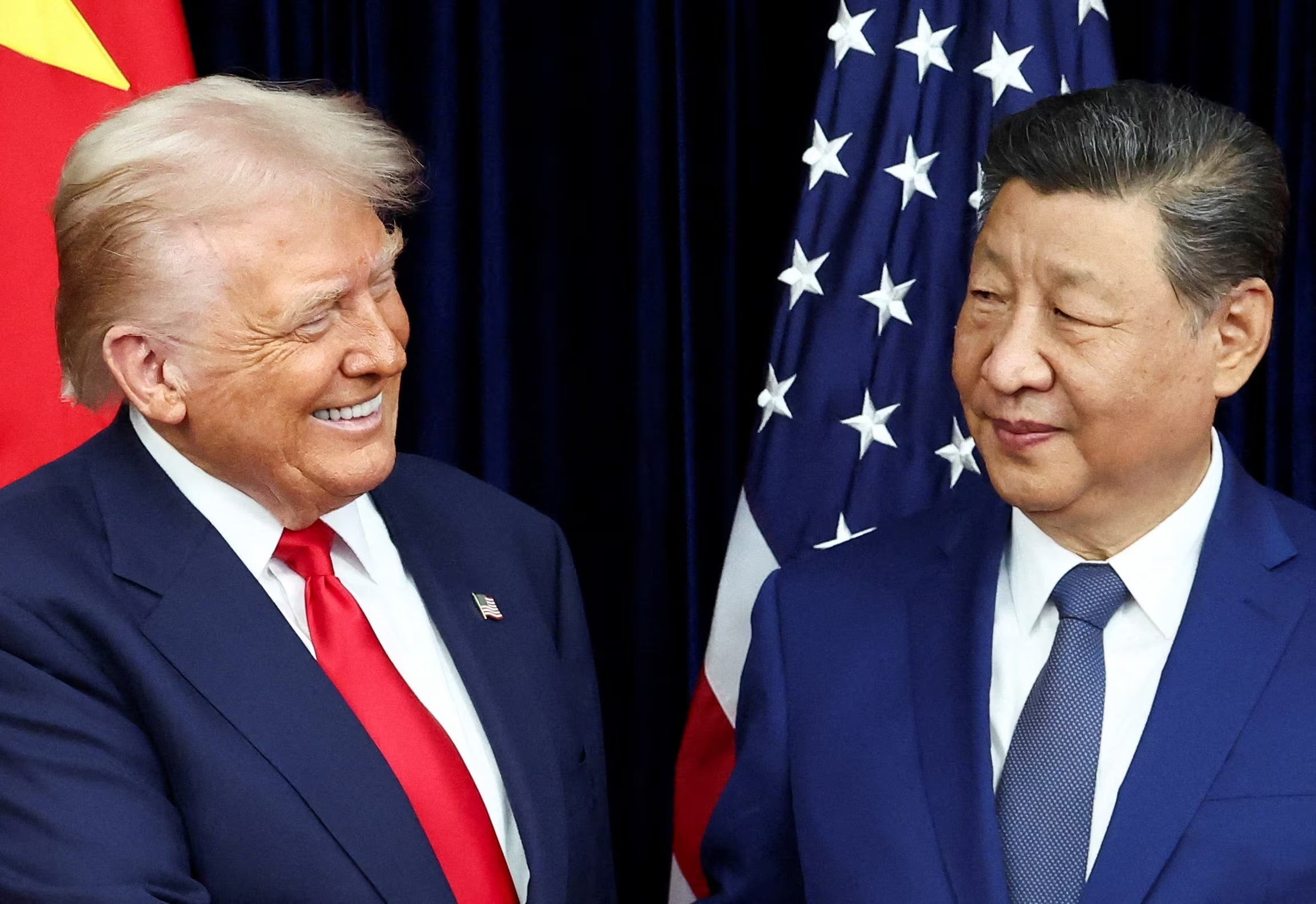In a dramatic pivot from brinkmanship to bargain, President Donald Trump has slashed U.S. tariffs on Chinese imports by 10 percentage points, dropping the average rate from 57% to 47%, following a high-stakes summit with Chinese President Xi Jinping in Busan, South Korea.
The October 30 meeting, lasting 100 minutes amid the Asia-Pacific Economic Cooperation (APEC) summit, dismantled what Trump called the “rare earths roadblock”—China’s sweeping export controls on critical minerals announced just weeks earlier.
This deal, hailed by Trump as “amazing—a 12 out of 10,” averts a full-blown trade war escalation and buys precious time for global supply chains, though skeptics warn it’s a temporary truce in an enduring rivalry.
The Summit: Handshakes Over Hardball
The Busan tarmac served as an unlikely stage for diplomacy. Trump, flanked by Secretary of State Marco Rubio and Commerce Secretary Howard Lutnick, greeted Xi with a firm handshake and whispers of mutual respect. “Xi is a friend and a great leader,” Trump later quipped aboard Air Force One, rating the talks higher than his own wedding. Xi, more reserved, echoed the sentiment via state media, noting the envoys’ prior “basic consensus” in Kuala Lumpur had paved the way. No joint presser followed, but White House fact sheets and Trump’s Truth Social posts filled the void with details of a “framework agreement” set for annual review.
This wasn’t cold-called chaos; groundwork laid at the ASEAN summit in Malaysia earlier that month neutralized Trump’s threatened 100% tariffs on Chinese goods, set to hit November 1. The Busan face-off sealed it, with Trump emerging to declare, “We have a deal. Now, every year, we’ll renegotiate.” Xi’s delegation, including Foreign Minister Wang Yi, left without comment, but Xinhua touted “pragmatism grounded in national interest.”
The Stakes: Rare Earths as the Ultimate Leverage
At the heart of the impasse: rare earth elements (REEs)—metals like neodymium and dysprosium essential for magnets in electric vehicles, wind turbines, smartphones, and F-35 jets. China dominates 85% of global processing and 60% of mining, a monopoly forged over decades while the U.S. “slept at the switch,” as Treasury Secretary Scott Bessent admitted. Beijing’s October 9 announcement of “expansive new export controls” on REEs and magnets—expanding prior restrictions from 2022 and April 2025—sparked panic. Exports had already plunged 30% year-over-year in September, threatening U.S. defense contractors and Tesla’s supply lines.
Trump’s response? A tariff bazooka: hikes to 100% on Chinese imports, plus curbs on U.S. software exports to China. “They hit us with rare earths; we’ll hit them where it hurts,” he posted on Truth Social. Soybean farmers, battered by China’s boycott, lobbied hard—U.S. ag exports to China had cratered 50% since 2018. Fentanyl precursors, fueling America’s opioid crisis, added moral urgency; China supplies 90% of the chemicals.
The “roadblock” metaphor captured it: Without REEs, U.S. tech and green energy ambitions stall. Xi’s move was a masterstroke of asymmetric warfare—low-cost pain for Beijing, existential for Washington.
Deal Breakdown: Wins, Pauses, and Promises
The Busan blueprint is pragmatic horse-trading:
-
U.S. Concessions: Tariffs on fentanyl-linked imports drop from 20% to 10%, effective November 10; broader Section 301 exclusions extended to November 2026. No full rollback—19% baseline tariffs linger as “insurance.” Trump paused new semiconductor export controls, easing probes into firms like Nexperia.
-
China’s Commitments: Suspends October’s REE export regime for one year, issuing “general licenses” effectively lifting 2022/2025 curbs on gallium, germanium, and graphite for U.S. users. Halts retaliatory tariffs and “unreliable entity” listings since March 2025. Pledges to buy 12 million metric tons of U.S. soybeans by year-end, scaling to 25 million annually through 2028—worth $15 billion yearly. Cracks down on fentanyl chemicals, banning shipments to North America.
-
Shared Ground: Vague nods to Ukraine (Trump: “We’ll work together”) and Trump’s April Beijing visit; Xi eyes a U.S. trip later. Taiwan? Unmentioned—smart sidelining of a flashpoint.
It’s a one-year “pause,” not permanence. China retains leverage; prior REE quotas persist globally, not just for the U.S.
Implications: Relief for Markets, Risks for Resilience
Markets exhaled: Soybean futures jumped 5%, REE stocks like MP Materials surged 8%, and the S&P 500 notched gains amid “risk-on” vibes. Consumers could see cheaper EVs and gadgets; farmers toast renewed China sales. Semiconductors breathe easier without Beijing’s entity lists. Globally, it’s a de-risking win—supply chains unclog, inflation eases.
Yet, shadows loom. The U.S. remains “vulnerable,” per Washington Post analysis; domestic REE production (e.g., Mountain Pass mine) covers just 15% of needs, with full independence 5–10 years away. Critics like CNN’s Fareed Zakaria call it a “deferral,” not resolution—Xi can reimpose curbs post-2026, forcing tariff reprisals. X users split: MAGA cheers “Trump wins again” with soybean memes, while skeptics decry “folding to Beijing.” Domestically, it bolsters Trump’s “America First” cred ahead of midterms, but progressives like Sen. Adam Schiff blast it as “short-term sugar for long-term pain.”
Environmentally, eased REE flows aid green tech but underscore mining’s toll—China’s dominance stems from lax regs the U.S. won’t match. Geopolitically, it signals pragmatism: Allies like Japan and Vietnam, fresh off Trump pacts, watch warily as U.S.-China ties thaw.
Why Now? Leverage, Legacy, and Looming Deadlines
Timing was everything. Trump’s Asia tour—ASEAN to APEC—boxed in Xi amid China’s economic wobbles: 4.6% GDP growth, youth unemployment at 17%, and fentanyl backlash eroding U.S. goodwill. Beijing needed farm imports to stabilize rural unrest and REE revenue to fund subsidies. Trump’s tariffs, while painful for U.S. consumers ($1,200/household annually), forced Xi’s hand—export controls risked alienating Europe and Japan too.
For Trump, it’s legacy gold: Echoing Phase One’s 2020 “success” (despite unmet targets), it showcases “peace through strength.” Midterm optics? Impeccable—farm states cheer, Wall Street stabilizes. Xi, facing domestic scrutiny, claims a “strong hand” on heavy REEs for defense tech. Broader context: Russia’s Ukraine quagmire and Taiwan tensions make de-escalation a mutual hedge against chaos.
As X analyst @MarioNawfal posted: “Adversaries can negotiate without capitulating.” 2 Bessent’s “warp speed” de-risking—ramping U.S. mining, ally pacts—fills the gap.
The Road Ahead: Truce or Tease?
Trump’s tariff trim and REE reprieve mark a rare U.S.-China detente, blending bluster with breakthrough. It stabilizes $575 billion in annual trade, saves lives via fentanyl curbs, and feeds Midwestern heartlands. Yet, with a one-year fuse, it’s no panacea—China’s monopoly endures, U.S. vulnerabilities persist.
As Trump jets home, eyes turn to April’s Beijing visit. Will it evolve into enduring accord, or unravel into round two? History—from Nixon’s 1972 ping-pong to Trump’s first-term tweets—reminds: Superpower deals are fragile. For now, the roadblock’s gone, but the highway’s still contested. In trade’s endless chess game, this move buys time—and perhaps, a checkmate deferred.










Share:
Trump’s Shocking Directive: Resuming U.S. Nuclear Testing After 33 Years
The Vance-Kirk Embrace: Mourning, Politics, and the Shadows of Charlie Kirk’s Assassination